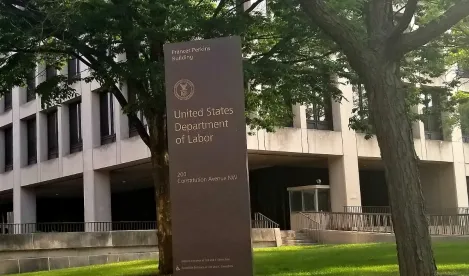The Department of Labor (DOL) Employee Benefits Security Administration (EBSA) recently finalized a series of rules viewed as key Trump administration priorities. The rules include:
-
Prohibited Transaction Exemption 2020-02, Improving Investment Advice for Workers & Retirees (Fiduciary Rule Exemption);
-
The final rule on Fiduciary Duties Regarding Proxy Voting and Shareholder Rights (Proxy Voting Rule); and
-
The final rule on Financial Factors in Selecting Plan Investments (ESG Rule).
This alert provides a brief overview of the final rules and the potential policy tools available to the Biden administration should it seek to revisit them.
BACKGROUND
The issuance of the rules continues the significant, multi year, partisan policy debates regarding the scope of Employee Retirement Income Security Act (ERISA) fiduciary responsibilities, including on issues related to investing based on environmental, social, or governance (ESG) factors, and proxy access. The DOL fiduciary duty rule, promulgated in fits and starts during the Obama administration, became a top target of the Trump administration. The Trump administration also revisited Obama administration-era guidance on the consideration of ESG factors in the ERISA context by focusing on whether a fiduciary subordinates the interests of plan participants and beneficiaries to non-“pecuniary” objectives.
Although the Trump administration took steps that may insulate the policies contemplated in the final rules from being reversed in the short term, the rules will be a key area of scrutiny for the incoming Biden administration’s DOL EBSA. In addition to anticipated attempts by the Biden administration to delay, suspend, or alter the final rules, the final rules may also be the subject of potential litigation.
FIDUCIARY RULE EXEMPTION
On 18 December 2020, the Fiduciary Rule Exemption was published in the Federal Register1 and is scheduled to become effective 16 February 2021. While the Fiduciary Rule Exemption does not technically change the regulatory definition of what it means to be a fiduciary under ERISA or the Internal Revenue Code (Code), the preamble to the Fiduciary Rule Exemption includes an interpretation (Final Interpretation) that alters longstanding guidance on how DOL will determine whether a person is a fiduciary by reason of providing non-discretionary investment advice to a plan subject to ERISA or the Code (including an individual retirement account (IRA)). Under the Final Interpretation, advice to rollover assets from an ERISA-covered plan to an IRA is more likely to be deemed to be fiduciary investment advice.
The Fiduciary Rule Exemption is materially similar to its proposed form2 although there are some relatively minor changes.3
With respect to the Final Interpretation:
-
There must be ongoing advice to a “plan” (whether subject to ERISA or the Code) to attain fiduciary status. Recommendations made only with respect to non-plan assets are disregarded for this purpose;4 and
-
There is a specific statement that introductory “hire me” discussions should generally not be viewed as fiduciary advice (although any investment recommendation that accompanies such discussion is separately evaluated to determine whether it would be considered fiduciary advice).
In addition, DOL provides that the non-enforcement policy in Field Assistance Bulletin (FAB) 2018-02 will remain in effect until 20 December 2021, to provide a transition period. During this time, neither DOL nor the IRS will pursue prohibited transaction claims against investment advice fiduciaries who comply with the requirements of the FAB.5
Although, as discussed further below, the Fiduciary Rule Exemption may be stopped by a new administration from ever becoming effective, the impact of the Final Interpretation may stay with us, as DOL asserts such interpretations are not subject to notice and comment.6 As a result, if the Fiduciary Rule Exemption never becomes effective, some advice providers may find themselves in a situation where they need to rely on an exemption that does not exist. However, the non-enforcement policy in FAB 2018-02 should continue to provide some protection even in that scenario,7 allowing the new administration to address these issues.
PROXY VOTING RULE
DOL’s final Proxy Voting Rule was published in the on 16 December 2020.8 Many of the more substantive and controversial provisions from the proposal9 were removed in the final Proxy Voting Rule, allowing it to become effective on 15 January 2021, 30 days after publication in the Federal Register (in contrast to the 60 days required by a “major” rule).
The Proxy Voting Rule codifies existing DOL guidance that the fiduciary duty to manage plan assets that are shares of stock includes the fiduciary duty to manage shareholder rights appurtenant to those assets, such as the right to vote proxies. When exercising these duties, a fiduciary may not subordinate the interests of plan participants and beneficiaries in receiving financial benefits under a plan to non-pecuniary objectives. Many of the comments and much of the discussion around the Proxy Voting Rule has focused on whether the rule is intended to prevent fiduciaries from voting proxies based on ESG factors. The preamble to the Proxy Voting Rule acknowledges that ESG factors may be either pecuniary or non-pecuniary and “the relevant question is not whether a factor under consideration is ‘ESG,’ but whether it is a pecuniary factor relevant to the exercise of a shareholder right or to an evaluation of the investment or investment course of action.”10
The final Proxy Voting Rule eliminated the main controversial provisions from the proposal that said a fiduciary “must” vote any proxy where the fiduciary prudently determined that the matter being voted upon would have an economic impact on the plan, and conversely “must not” vote a proxy if it determines the opposite. In addition, the Proxy Voting Rule eliminated the controversial provision that allowed a fiduciary to rely on a policy that it would vote with management’s recommendations in certain cases.
The Proxy Voting Rule includes a statement to clarify that a fiduciary is not required to vote all proxies. It also provides some additional guidance on fiduciary responsibility in connection with the selection and oversight of proxy advisory firms and investment managers. The Proxy Voting Rule emphasizes the duty of a fiduciary on behalf of a plan that is investing in pooled funds that hold plan assets to assess the proxy voting policies of such funds before adopting such policies.
ESG RULE
We discussed the ESG Rule in our November 12 client alert.11 The ESG Rule was published in the Federal Register on 13 November 2020 and is effective 12 January 2021.
Similar to the Proxy Voting Rule, under the ESG Rule plan fiduciaries are not permitted to sacrifice investment return or take on additional investment risk to promote non-pecuniary benefits or any other non-pecuniary goals, and they may not subordinate the interests of the participants and beneficiaries in their retirement income or financial benefits under the plan to other objectives. A fiduciary’s evaluation of an investment must, except in rare “tie-breaking” scenarios, be based only on pecuniary factors.
EXECUTIVE TOOLS TO REVISIT THE POLICY OF THE PREVIOUS ADMINISTRATION
A shift in the party that controls the White House often results in a review of the policy actions by the previous administration. There are several tools that are available to revisit rulemakings and executive orders. As a starting point, similar to previous administrations, the incoming Biden administration is likely to issue an executive order directing the heads of executive branch departments and agencies to rescind orders, rules, guidelines, and policies that implemented a previous administration’s executive order, to the extent permitted by law.
The incoming Biden administration is also likely to suspend many, if not all, new rules that have not yet been finalized or published in the Federal Register. These actions would allow the incoming administration to have the opportunity to review executive orders and pending rules for consistency with the new administration’s policy direction.
With respect to a new administration’s authority to impact final rules, including the three final rules that are the subject of this alert, the authority is generally dependent on the final rule’s effective date. By way of background, under the Administrative Procedures Act (APA), a department or agency must generally provide a period of at least 30 days after a final rule is published in the Federal Register before the rule becomes effective.12 The Congressional Review Act extends the APA’s required period for “major” rules, providing that they “shall take effect on the latest of” 60 days after the date the rule is published in the Federal Register or submitted to Congress (whichever is later) or the date the rule would have otherwise taken effect.13
For final rules that are not effective by the time the new administration takes office, such as the Fiduciary Rule Exemption which was published in the Federal Register on 18 December 2020 and deemed to be a major rule and, therefore not scheduled to be effective until 16 February 2021, a new administration may suspend the final rule for the purposes of determining whether the final rule should be implemented, modified, or rescinded. These types of suspensions, which can ultimately be used to rescind rules, are common during a presidential transition; both the Trump administration and the Obama administration relied on these powers broadly.
For final rules that will be effective ahead of the new president’s inauguration, such as the Proxy Voting Rule and the ESG Rule, the new administration may rescind or amend the final rule by undertaking a new notice-and-comment rulemaking and providing a rational justification for why the rule is no longer appropriate in its current form. The notice-and-comment rulemaking process may limit the incoming administration’s ability to abandon an existing regulatory scheme; however, it permits an administration to implement well-reasoned alternatives.
As noted above, the Trump administration’s issuance of the Fiduciary Rule Exemption, the Proxy Voting Rule, and the ESG Rule are the next iterations of the significant, multi-year policy debates around the scope of ERISA fiduciary responsibilities, including on issues related to ESG investing and proxy access. These debates have not been limited to DOL; the SEC has considered Amendments for Proxy Voting Advice, Guidance Regarding Proxy Voting Responsibilities of Investment Advisers, and ESG issues, among others, as part of the Fund Names Rule. Although the Trump DOL’s issuance of final rules does create some hurdles for the incoming Biden administration to the extent it seeks to suspend or rescind the rules, given the significant ongoing interest on these policy issues, the Biden administration is likely to revisit them. It is possible that after some initial work to suspend the rules, or engage in message positioning, more significant work on revisiting the final rules may depend on the timing of confirmation of political appointee leadership at DOL and EBSA, and on bandwidth, as there is likely to be an immediate focus on urgent issues such as COVID-19 response.
CONGRESSIONAL REVIEW AND OVERSIGHT
Beyond the incoming administration, it is possible that members of Congress may attempt to take action against a final rule. Under the CRA, Congress may pass a Joint Resolution of Disapproval that, if signed by the president, deems recent administrative rulemaking to not have had any effect. The ability to use the CRA is dependent on a “look back” period determined by whether the rule is a “major rule” and the timing of the tolling of the look back period. However, most importantly, the CRA has rarely been successful, as it requires unified control of government. Looking ahead, it is unlikely to be a viable tool given that, at the time of this writing, Republicans are expected to control the Senate after the two run-off elections in Georgia. Even if Democrats win both the Georgia seats, Democrats could not afford to lose a single vote to pass a CRA resolution. Congress does not use the CRA often and given the tight margin House Democrats have and the lack of any room for error in the Senate, using the CRA would be high risk and time-intensive, particularly at a time when there are likely to be other policy agenda issues requiring Congress’s attention.
Congress could also use other authorities to curtail agency action, such as a passing a law to overturn a final rule under regular order or using an “appropriations rider,” which would prohibit the use of appropriated funds to carry out a designated activity. While stand-alone repeal legislation faces much of the same political dynamics as a CRA action, an appropriations rider has a slightly higher—albeit still limited—chance of success as part of the bipartisan, bicameral trading and compromise often associated with “must pass” legislation to fund continuing government operations.
Although legislative enactments face headwinds, members of Congress may also engage in oversight activities, such as hearings or information-gathering reviews, or introduce messaging legislation. These efforts could attempt to re-frame the final rules as problematic for a number of reasons and articulate a preferred approach. These exercises may not result in changes to the final rules, but could serve as an echo chamber to reinforce the Biden administration’s rulemaking approach.
CONCLUSION
As the incoming Biden administration enters office, it is likely that there will be efforts to revisit the Trump administration’s Fiduciary Rule Exemption, the Proxy Voting Rule, and the ESG Rule. We anticipate that uncertainty around these regulatory frameworks is likely to continue, with further changes expected through Congressional and/or administrative action in coming years. These developments may impact how stakeholders position themselves vis-à-vis each of the rules, and the next iteration of these policies will provide stakeholders with a fresh opportunity to influence to influence the policy debate.
1 85 Fed. Reg. 82798 (Dec. 18, 2020).
2 See our client alert on the proposal. Kristina M. Zanotti & Robert L. Sichel, DOL Proposes New “Fiduciary Rule” Exemption, Upends Longstanding Guidance on Rollover Advice, K&L GATES HUB (July 7, 2020).
3 Specifically, the final Fiduciary Rule Exemption narrows public access to a financial institution’s records, requires a rollover recommendation be accompanied by written disclosure of the reasons that it is in the retirement investor’s best interest, expands the officers that can certify the retrospective review, and adds a self-correction provision.
4 DOL backed down from its suggestion in the proposal that if rollover advice was provided as part of an ongoing advice relationship to an individual (even if the advice relationship has not previously involved the plan), such advice was more likely to be considered fiduciary investment advice.
5 These requirements include working diligently and in good faith to comply with “impartial conduct standards” as described in our previous client alert. Supra note 2.
6 85 Fed. Reg. at 82804.
7 If the Fiduciary Rule Exemption never becomes effective, the 20 December 2021 end-date for FAB 2018-02 will presumably also not be effective, and FAB 2018-02 will continue to remain in effect until DOL issues additional guidance.
8 85 Fed. Reg. 81658 (Dec. 16, 2020).
9 See our client alert on the proposal. Kristina M. Zanotti & Robert L. Sichel, DOL Proposes New Rule on Proxy Voting Duties – Potential Implications for Investment Managers and Other ERISA Fiduciaries, K&L GATES HUB (Oct. 15, 2020).
10 85 Fed. Reg. at 81662, note 30.
11 Kristina M. Zanotti & Robert L. Sichel, DOL Issues Final “ESG” Rule; Focuses on “Pecuniary” Factors, K&L GATES HUB (Nov. 12, 2020).
12 65 U.S.C. § 553(d).
13 5 U.S.C. § 801(a)(3).





 />i
/>i

